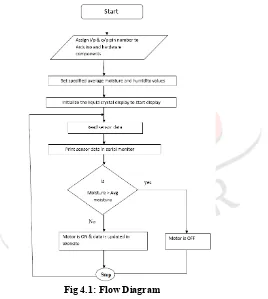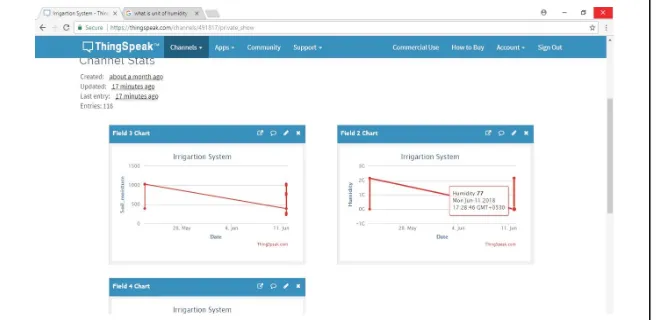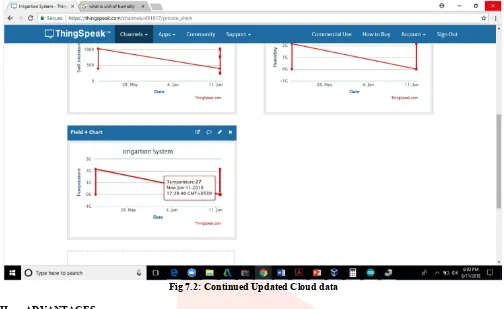IJEDR1902083 International Journal of Engineering Development and Research (www.ijedr.org) 434
Smart Drip Irrigation system
Raghavendra Sheddi, Meenakumari V. Umarani Assistant Professor
Rural Engineering College,Hulkoti
_____________________________________________________________________________________________________
Abstract - India is the agriculture based country, increasing energy costs and decreasing water supplies, point out the need for better water management. Irrigation management is a complex decision making process to determine when and how much water to apply to a growing crop to meet specific management objectives. If the farmer is far From the agricultural land he will not be noticed of current conditions. So, efficient water management plays an important role in the irrigated agricultural cropping systems. Drip irrigation allows water to drip slowly to the roots of plants, through a network of valves, pipes or emitter. It prevents soil erosion, saves water and can also supply fertilizers to crops. The most significant advantages of this technique is, it allows water conservation as water is supplied in a targeted manner near the root zone of plants in a drip by drip fashion. The Objective is to design a reliable, robust and intelligent drip irrigation controller device for regions devoid of reliable weather prediction and water supply. This system is intended to help farmers to make more efficient use of precious water while avoiding dehydration of crops.
Index Terms- IoT, Drip Irrigation, Arduino Nano.
_____________________________________________________________________________________________________
I. INTRODUCTION
This paper proposes intelligent and smart Irrigation system which can be used for controlling the watering or irrigation of plants. It controls the irrigation of plants automatically where the need of human intervention can be reduced. This mainly focused on wastage of water, which is a major concern of the modern era. By using the concept of modern irrigation system a farmer can save water up to 50%.
The agricultural sector consumes huge amount of water, followed by the domestic and the industrial sector. In India, Groundwater contributes to around 65% of the country’s total water demand, and plays an important role in shaping the nation’s economic and social development. On the other hand, feeding the country’s own population, which is 17% of the world with just 4% of world’s water resources at hand, is a big challenge. Balancing water demand among all sectors with finite and fragile water resources will be crucial for future economic growth and development. As water demand from cities and industries is increasing rapidly, the pressure is also mounting on agriculture to enhance water efficiency. Traditional irrigation methods are no longer viable and a paradigm shift is required to increase irrigation efficiency. With around two third of Indians depend upon agrarian economy, water is becoming a bottleneck for country’s socioeconomic balance and growth.
Conventional irrigation methods like overhead sprinklers, flood type feeding systems, wet the lower leaves and stem of the plants. The area between the crop rows become dry as the large amount of water is consumed by the flood type methods, in which case the farmer depends only on the incidental rainfalls. The crops are being infected by the leaf mould fungi as the soil surface often stays wet and is saturated after irrigation is completed. Overcoming these drawbacks new techniques are being adopted in the irrigation techniques, through which small amounts of water apply to the parts of the root zone of a plant. The plant soil moisture stress is prevented by providing the required amount of water resources frequently or often daily by which the moisture condition of the soil will retain well. The traditional techniques like sprinkler or surface irrigation requires nearly half of water sources. Even more precise amounts of water can be supplied for plants. As far as the foliage is dry, the plant damage due to disease and insects will be reduced, which further reduces the operating cost.
The dry rows between plants will lead to continuous federations during the irrigation process. Fertilizers can be applied through this type of system, and the cost required will also reduce. The erosion of soil and wind is much reduced by the recent techniques when compared with overhead sprinkler systems. The soil characteristics will define the form of the dripping nature in the root zone of a plant which receives moisture. As the method of dripping will reduce huge water losses it became a popular method by reducing the labour cost and increasing the yields. When the components are activated, all the components will read and gives the output signal to the controller, and the information will be displayed to the farmer. The sensor readings are analog in nature, so the ADC pin on the controller will convert the analog signals into digital format, and it will be displayed on the LCD Panel.
II. LITERATURE SURVEY
The literature survey is carried out related in the “SMART DRIP IRRIGATION SYSTEM ” is as follows,
K K Namala et.al [1] introduces a “Smart irrigation with embedded system”. Raspberry Pi (open source) is used in the design of the prototype model in making the system compact and sustainable. The system has a sensor which measures the moisture of the soil and switch relay, which controls solenoid valve according to the requirement.
IJEDR1902083 International Journal of Engineering Development and Research (www.ijedr.org) 435 and quality of products. The Agriculture stick being proposed via this paper is integrated with Arduino Technology, Breadboard mixed with various sensors and live data feed can be obtained online from Thingsspeak.com.
Chandan Kumar Sahu et.al [3] have proposed “ A low cost Irrigation control system”. The objectives of this paper were to control the water motor automatically and select the direction of the flow of water in pipe with the help of soil moisture sensor. Finally, send the information (operation of the motor and direction of water) of the farm field to the mobile message and g-mail account of the user.
Luis Ruiz-Garcia et.al [4] have given “Review of sensor technologies”. This paper reviews the technical and scientific state of the art of wireless sensor technologies and standards for wireless communications in the Agri-Food sector. These technologies are very promising in several fields such as environmental monitoring, precision agriculture, cold chain control or traceability.
Klute, A.et.al [5] has introduced “Physical and Mineralogical Methods” This paper given enough information on physical and mineralogical properties of soil.
III. OBJECTIVE
There is an urgent need for a system that makes the agricultural process easier and burden free from the farmer’s side.The ability to conserve the natural resources as well as giving a splendid boost to the production of the crops is one of the main aims.To save farmers effort, water and time the irrigation management is a complex decision making process to determine when and how much water to apply to a growing crop.If the farmer is far from the agricultural land he will be noticed of current conditions.
IV.FLOW DIAGRAM
Fig 4.1: Flow Diagram
The above flow diagram describes the working procedure of the irrigation system. We are giving the input through the sensor like soil moisture sensor, humidity sensor and getting the output through the LCD display. First, we assign the input and output pin number to the Arduino board and hardware components. After assigning input and output pin numbers, it sets the specified average moisture and humidity value. In our program, we set the average moisture as 700 and humidity value as 30. After testing some values we are getting the threshold value. Next we are initializing the liquid crystal display to start display the moisture value and humidity value. After initializing the LCD display we have to read the sensor data. These readable sensor data will be printed on the serial monitor. The next we have to test the conditions, i.e., if the moisture value is greater than the average moisture value, then the motor is turned off and data will be updated on the website. After updating, again it will read the sensor data and check the condition continuously. If the moisture value is not greater than the average moisture level, then the motor will be turned on. And again, it reads the sensor data and check the condition continuously.
IJEDR1902083 International Journal of Engineering Development and Research (www.ijedr.org) 436 Fig 5.1: Circuit Diagram
Hardware components such as LCD, Arduino Nano, Node MCU, Soil moisture sensor, Humidity sensor, Motor is used in our system. Arduino Nano and node MCU are used as the controller. Arduino Nano controls the data. Node MCU is used as the WiFi module in between cloud and controller. After assembling the circuit and done with coding, the code is uploaded on to the Arduino Nano and the node MCU to connect to the Internet. The Arduino is connected to soil moistures and humidity sensor. The sensor senses/measures the respective value. The soil moisture sensor measures the moisture in the soil and humidity sensor will measure the humidity temperature in air. The values will be transmitted to the cloud that is to the ThingSpeak. The values updated as sensor measures the data.
The data will be processed in Arduino, controlling measures is taken and based on that the motor will turn on/off.If the moisture level is low and humidity is low then motor turns on and the water is poured to plants. If the moisture level is high, then motor turns off. This all value will be getting updated on the website through the graph. Node MCU is a WiFi module which connects to the cloud as well as to Arduino Nano I2C protocol.
VI. IMPLEMENTATION
The system has been implemented using the Aurdino Nano and ESP8266. The code part of the Aurdino nano and ESP8266 is made using the Aurdino IDE Software. The sensors and actuators are configured under some test condition, such that threshold values are set. The libraries such as Liquid Crystal for LCD display, Wire.h for I2C communication, DHT.h for humidity and temperature sensor are used in coding.
VII. RESULTS AND SNAPSHOTS
The testing is done under several conditions of temperature, humidity and also moister, by various test analysis the threshold levels for all climatic conditions are set. Table 7.1 shows the details of the same in the below table. The cloud updated data are shown in the following figures.
Sensor / Actuators Threshold values and motor condition Humidity >30, Motor on
Soil Moisture >700, Motor OFF
Table 7.1: Working conditions
Thing Speak was originally launched by ioBridge in 2010 as a service in support of IoT applications. According to its developers, "ThingSpeak is an open-source Internet of Things (IoT) application and API to store and retrieve data from things using the HTTP protocol over the Internet or via a Local Area Network. ThingSpeak enables the creation of sensor logging applications, location tracking applications, and a social network of things with status updates". Figure 7.1 and Figure 7.2 shows snapshots.
IJEDR1902083 International Journal of Engineering Development and Research (www.ijedr.org) 437 Fig 7.2: Continued Updated Cloud data
VIII. ADVANTAGES
i) Saves water and money - Smart irrigation practices help to limit water use, which can save you money on your utility bill. Trade irrigation systems deliver exactly the amount of water that is needed. This helps to keep plants healthy and beautiful without over watering and without wasting water.
ii) Protect the community’s water supply for generating - By saving water, it helps to maintain water supply for community because water will be continuously saved and protected.
iii) Minimize needs for infrastructure to store and carry water - If you are not using as much water as you’re before, you will no longer need to invest in infrastructure to store and carry water. This storage could be costing you a lot of money through property taxes. This is another great example of how the smart drip irrigation system can save your money.
iv) Make maintaining a yard easy and convenient - In the past few years, irrigation technology has evolved to the point where we have access to automatic sprinkler system that deliver the right amount of water only when water is needed.
IX. CONCLUSION AND FUTURE SCOPE
The Smart drip irrigation system is designed to control the irrigation system, depending upon the climatic conditions. The climatic conditions are updated in the cloud with respect to the time. It enables the farmers to know about the status of the climate and the working of the irrigation system. The primary application of this system is for the farmers and gardeners who do not have enough time to water their crops/plants. It also covers those farmers who are wasting water during irrigation. As water supplies become scarce and polluted, there is a need to irrigate more efficiently in order to minimize water use and chemical leaching. Recent advances in soil, water sensing make the commercial use of this technology possible to automate irrigation management for vegetable production. However, research indicates that different sensor types perform under all conditions with no negative impact on crop yields with reductions in water use range as high as 70% compared to traditional practices.
In the future, we can even interface more sensors which give calcium, ammonium, zinc values this data can be transferred to agriculture and chemical department. In addition to water level sensor and rain indicator sensor can be added to know the water levels in the tank.
REFERENCES
[1] Authors-K K Namala School of Engineering, Central University of Karnataka, Kalaburagi Krishna Kanth Prabhu A VSchool of Engineering, Central University of Karnataka, Kalaburagi.
IJEDR1902083 International Journal of Engineering Development and Research (www.ijedr.org) 438 [3] Authors-Chandan Kumar Sahu Department of ECE sambalpur university institute of information Technology.
Pramitee BeheraDepartment of ECE sambalpur university institute of information Technology.
[4] Luis Ruiz-Garcia, Loredana Lunadei 1, Pillar Barreiro 1 and Jose Ignacio Robla 2 “A Review of Sensor Technologies and Applications in Agriculture and Food Industry: State of the Art and Current Trends” Sensors 2009, 9, 4728-4750; doi:10.3390/s90604728.


